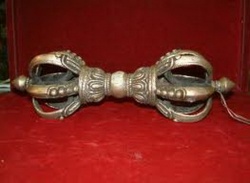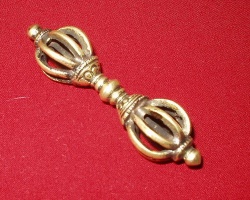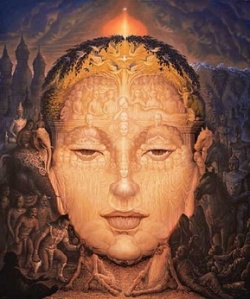Vajra
Vajra (Devanagari: वज्र; Chinese: 金剛 jīngāng; Tibetan: རྡོ་རྗེ། Dorje; Japanese: 金剛杵 kongōsho) is a Sanskrit word meaning both thunderbolt and diamond. it is also a common male name in Tibet and Bhutan. Additionally it is a symbolic Ritual object that symbolizes both the properties of a diamond (indestructibility) and a thunderbolt (irresistible force).
The vajra is used symbolically by the Dharma traditions of Buddhism, Jainism and Hinduism, often to represent firmness of spirit and Spiritual Power. The use of the vajra as a symbolic and Ritual tool spread from India along with Indian Religion and culture to other parts of East and Southeast Asia.
Early descriptions
The earliest mention of the Vajra is in the Rigveda, a part of four Vedas. It is described as the weapon of Indra, the God of Heaven and the chief deity of the Rigvedic pantheon. Indra is described as using the Vajra to kill sinners and ignorant persons. The Rigveda states that the weapon was made for Indra by Tvastar, the maker of divine instruments. The associated story describes Indra using the Vajra, which he held in his hand, to slay the Asura Vritra, who took the Form of a serpent.
On account of his skill in wielding the Vajra, some epithets used for Indra in the Rigveda were Vajrabhrit (bearing the bolt), Vajrivat or Vajrin (armed with the bolt), Vajradaksina (holding the bolt in his right hand), and Vajrabahu or Vajrahasta (holding the Vajra in his hand). The association of the Vajra with Indra was continued with some modifications in the later Puranic literature, and in Buddhist works. Buddhaghosa, a major figure of Theravada Buddhism in the 5th century, identified the Bodhisattva Vajrapani with Indra.
The Vajra in the Puranas
Indra's Vajra as the privy seal of King Rama VI of Thailand.
Many later Puranas describe the Vajra, with the story modified from the Rigvedic original. One major addition involves the role of the Sage Dadhichi. According to one account, Indra, the King of the devas was once driven out of devaloka by an Asura named Vritra. The Asura was the recipient of a boon whereby he could not be killed by any weapon that was known till the date of his receiving the boon and additionally that no weapon made of wood or metal could harm him. ) Indra, who had lost all hope of recovering his kingdom was said to have approached Shiva who could not help him. Indra along with Shiva and Brahma went to seek the aid of Vishnu. Vishnu revealed to Indra that only the weapon made from the bones of the sage Dadhichi would defeat Vritra. Indra and the other devas therefore approached the sage, whom Indra had once beheaded, and asked him for his aid in defeating Vritra. Dadhichi acceded to the devas' request but said that he wished that he had time to go on a Pilgrimage to all the holy rivers before he gave up his Life for them. Indra then brought together all the waters of the holy rivers to Naimisharanya, thereby allowing the sage to have his wish fulfilled without a further loss of time. Dadhichi is then said to have given up his Life by the Art of Yoga after which the Devas fashioned the Vajrayudha from his spine. This weapon was then used to defeat the Asura, allowing Indra to reclaim his place as the King of devaloka
Another version of the story exists where Dadhichi was asked to safeguard the Weapons of the devas as they were unable to match the arcane arts being employed by the Asuras to obtain them. Dadhichi is said to have kept at the task for a very long time and finally tiring of the job, he is said to have dissolved the Weapons in sacred water which he drank. ) The devas returned a long time later and asked him to return their Weapons so that they might defeat the Asuras, headed by Vritra, once in for all. Dadhichi however told them of what he had done and informed them that their Weapons were now a part of his bones. However, Dadhichi, realising that his bones were the only way by which the devas could defeat the Asuras willingly gave his Life in a pit of Mystical flames he summoned with the Power of his austerities. Brahma is then said to have fashioned a large number of Weapons from Dadhichi's bones, including the Vajrayudha, which was fashioned from his spine. The devas are then said to have defeated the Asuras using the Weapons thus created.
There have also been instances where the War God Skanda (Murugan) is described as holding a Vajra. Skanda is also the name of a Bodhisattva in Mahayana Buddhism who wields a Vajra.
Vajra in Vajrayana Buddhism
In Buddhism the vajra is the Symbol of Vajrayana, one of the three major branches of Buddhism. Vajrayana is translated as "Thunderbolt Way" or "Diamond Way" and can imply the thunderbolt experience of Buddhist Enlightenment or Bodhi. It also implies indestructibility, just as diamonds are harder than other gemstones.
In Tantric Buddhism (Vajrayana) the vajra and Ghanta (Bell) are used in many rites by a Lama or any Vajrayana practitioner of sadhanas. The Dorje is a male polysemic Symbol that represents many things for the tantrika. The vajra is representative of upaya whereas its companion tool, the Bell which is a female Symbol, denotes Prajna. Some deities are shown holding each the vajra and Bell in separate hands, symbolizing the union of the forces of Compassion and Wisdom, respectively.
Vajrasattva holds the vajra in his right hand and a Bell in his left hand.
In the tantric traditions of Buddhism, the vajra is a Symbol for the nature of reality, or Sunyata, indicating endless creativity, potency, and skillful activity. The term is employed extensively in tantric literature: the term for the Spiritual teacher is the vajracarya; instead of Bodhisattva, we have Vajrasattva, and so on. The practice of prefixing terms, names, places, and so on by vajra represents the conscious attempt to recognize the transcendental aspect of all Phenomena; it became part of the process of "sacramentalizing" the activities of the Spiritual practitioner and encouraged him to engage all his psychophysical energies in the Spiritual Life.
An instrument symbolizing vajra is also extensively used in the Rituals of the Tantra. It consists of a spherical central section, with two symmetrical sets of five prongs, which arc out from Lotus blooms on either side of the sphere and come to a point at two points equidistant from the centre, thus giving it the appearance of a "diamond sceptre", which is how the term is sometimes translated.
Various figures in Tantric iconography are represented holding or wielding the vajra. Three of the most famous of these are Vajrasattva, Vajrapani, and Padmasambhava. Vajrasattva (lit. vajra-being) holds the vajra, in his right hand, to his Heart. The figure of the Wrathful Vajrapani (lit. vajra in the hand) brandishes the vajra, in his right hand, above his head. Padmasambhava holds the vajra above his right knee in his right hand.
Symbolism
The vajra is made up of several parts. In the center is a sphere which represents Sunyata, the primordial nature of the Universe, the underlying unity of all things. Emerging from the sphere are two eight petaled Lotus Flowers. One represents the phenomenal World (or in Buddhist terms Samsara), the other represents the noumenal World (or Nirvana). This is one of the fundamental dichotomies which are perceived by the unenlightened. The physical manifestation of the vajra, also called Dorje in this context, is the male organ.
Arranged equally around the mouth of the Lotus are two, four, or eight creatures which are called makaras. These are mythological half-fish, half-crocodile creatures made up of two or more Animals, often representing the union of opposites, (or a harmonisation of qualities that transcend our usual experience). From the mouths of the makaras come tongues which come together in a point.
The five pronged vajra (with four makaras, plus a central prong) is the most commonly seen vajra. There is an elaborate system of correspondences between the five elements of the noumenal side of the vajra, and the phenomenal side. One important correspondence is between the five "poisons" with The Five Wisdoms. The five poisons are the Mental states that obscure the original purity of a being's Mind, while The Five Wisdoms are the five most important aspects of the Enlightened Mind. Each of The Five Wisdoms is also associated with a Buddha figure. (see also Five Wisdom Buddhas)
At the centre of the vajra is a flattened sphere representing the Dharmata as the 'sphere of actualreality'. This sphere is sealed within by the syllable HUM, whose three component sounds representfreedom from
Karma
(Hetu), freedom from conceptual Thought (Uha) and the groundlessness of alldharmas (M). On either side of the central hub are three rings [which] symbolise the spontaneous blissof Buddha nature as
Emptiness
, signlessness and effortlessness. Emerging from the three rings oneither side are two eight-petalled lotuses. The sixteen petals represent the sixteen modes of Emptiness.The upper Lotus petals also represent the eight
Bodhisattvas
, and the eight lower petals, the eightfemale consorts. Above the Lotus bases are another series of three pearl-like rings, whichcollectively represents the
six perfections
of Patience, Generosity, discipline, effort,Meditation and Wisdom. A full moon disc crowns each of the lotuses, symbolising the fullrealisation of absolute and relative
Bodhicitta
Emerging from the moon discs are fivetapering prongs, forming a spherical cluster or cross. The four [outer] curved prongs curveinwards to the central prong, symbolising that the
four Aggregates
of Form, Feeling,Perception and motivation depend upon the fifth Aggregate of Consciousness. The five upperprongs of the vajra represent the Five Buddhas (Akshobhya, Vairochana, Ratnasambhava, Amitabhaand Amogasiddhi), and the unity of their Five wisdoms, attributes and qualities. The five lower prongsrepresent the female consorts of the Five Buddhas (Mamaki, Lochana, Vajradhatvishvari, Pandaraand Tara) and the unity of their qualities and attributes. The Five Buddhas and their consorts symbolisethe elimination of The five aggregates of personality. The ten prongs together symbolise the
ten perfections
(the six mentioned above plus skilful means, aspiration, inner strength, and pure awareness); the 'Ten grounds' or progressive levels of realisation of a Bodhisattva; and the
tendirections
. Each of the outer prongs arise from the heads of Makaras (sea monster). The fourMakaras symbolise the
Four Immeasurables
(Compassion, Love, sympathetic Joy and Equanimity); thefour doors of Liberation (Emptiness, signlessness, wishlessness and lack of composition); the conquest of the four Maras (emotional Defilements, passion, Death, divine pride and lust); the four activities orkarmas; the four purified elements (air, Fire, water, earth); and the four joys (Joy, supreme Joy, the joyof cessation and innate Joy).The tips at the end of the central prong may be shaped like a tapering pyramid or four-faceted jewel,which represents Mount Meru as the axial centre of both the outer macrocosm and inner microcosm.The twin faces of the symmetrical vajra represent the unity of relative and Absolute truth.


